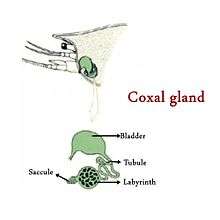Coxal gland
The coxal gland is a gland found in some arthropods, for collecting and excreting urine. They are found in all arachnids (with the exception of some Acari), and in other chelicerates, such as horseshoe crabs.[1] The coxal gland is thought to be homologous with the antennal gland of crustaceans. The gland consists of an end sac (saccule), a long duct (labyrinth) and a terminal bladder (reservoir).[2] There is generally only one pair (two in some spiders), and they open on the coxae of the walking legs.[1] The coxal secretion of adult female ticks of Ornithodoros erraticus contains a sex pheromone.[3]

Coxal gland and its components
References
- Colin Little (1983). "Chelicerates". The Colonisation of Land: Origins and Adaptations of Terrestrial Animals. Cambridge University Press. pp. 106–126. ISBN 978-0-521-25218-8.
- H. S. Bhamrah & Kavita Juneja (2002). "Scorpions". An Introduction to Arthropoda (2nd ed.). Anmol Publications. pp. 317–342. ISBN 978-81-261-0673-8.
- Schlein, Y.; Gunders, A. E. (1981). "Pheromone of Ornithodoros spp. (Argasidae) in the coxal fluid of female ticks". Parasitology. 82 (3): 467–471. doi:10.1017/S0031182000066993.
This article is issued from Wikipedia. The text is licensed under Creative Commons - Attribution - Sharealike. Additional terms may apply for the media files.